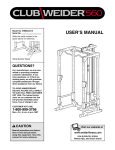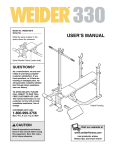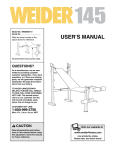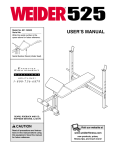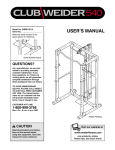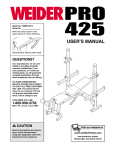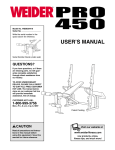Download Weider PRO XT75 User`s manual
Transcript
Model No. 831.153220 Serial No. USER’S MANUAL Write the serial number in the space above for reference. Serial Number Decal SEARS, ROEBUCK AND CO., HOFFMAN ESTATES, IL 60179 CAUTION Read all precautions and instructions in this manual before using this equipment. Save this manual for future reference. Visit our website at www.weiderfitness.com new products, prizes, fitness tips, and much more! TABLE OF CONTENTS WARNING DECAL PLACEMENT . . . . . . . . . . . . . . . . . . . . . . . . . . . . . . . . . . . . . . . . . . . . . . . . . . . . . . . . . . 2 IMPORTANT PRECAUTIONS . . . . . . . . . . . . . . . . . . . . . . . . . . . . . . . . . . . . . . . . . . . . . . . . . . . . . . . . . . . . . 3 BEFORE YOU BEGIN . . . . . . . . . . . . . . . . . . . . . . . . . . . . . . . . . . . . . . . . . . . . . . . . . . . . . . . . . . . . . . . . . . . 4 PART IDENTIFICATION CHART . . . . . . . . . . . . . . . . . . . . . . . . . . . . . . . . . . . . . . . . . . . . . . . . . . . . . . . . . . . 5 ASSEMBLY . . . . . . . . . . . . . . . . . . . . . . . . . . . . . . . . . . . . . . . . . . . . . . . . . . . . . . . . . . . . . . . . . . . . . . . . . . . 6 ADJUSTMENTS . . . . . . . . . . . . . . . . . . . . . . . . . . . . . . . . . . . . . . . . . . . . . . . . . . . . . . . . . . . . . . . . . . . . . . 12 EXERCISE GUIDELINES . . . . . . . . . . . . . . . . . . . . . . . . . . . . . . . . . . . . . . . . . . . . . . . . . . . . . . . . . . . . . . . 14 ORDERING REPLACEMENT PARTS . . . . . . . . . . . . . . . . . . . . . . . . . . . . . . . . . . . . . . . . . . . . . . . .Back Cover FULL 90-DAY WARRANTY . . . . . . . . . . . . . . . . . . . . . . . . . . . . . . . . . . . . . . . . . . . . . . . . . . . . . . . Back Cover Note: A PART LIST/EXPLODED DRAWING is attached in the center of this manual. Remove the PART LIST/EXPLODED DRAWING before beginning assembly. WARNING DECAL PLACEMENT The decal shown at the right has been applied to the weight rack. If the decal is missing, or if it is not legible, please call our toll-free HELPLINE at 1-800-736-6879, Monday through Saturday, 7 a.m. until 7 p.m. Central Time (excluding holidays), to order a free replacement decal. Apply the replacement decal in the location shown. ! WARNING • Misuse of this product may result in serious injury. • Read user’s manual and follow all warnings and operating instructions prior to use. • Do not allow children on or around machine. • Replace label if damaged, illegible, or removed. WEIDER is a registered trademark of ICON Health & Fitness, Inc. 2 IMPORTANT PRECAUTIONS WARNING: To reduce the risk of serious injury, read the following important precautions before using the weight rack. 1. Read all instructions in this manual before using the weight rack. Use the weight rack only as described in this manual. 10. Always secure weights with the weight clips when they are mounted on the barbell or the weight carriage. 2. It is the responsibility of the owner to ensure that all users of the weight rack are adequately informed of all precautions. 11. Always make sure there is an equal amount of weight on each end of the barbell or the weight carriage. 3. The weight rack is intended for home use only. Do not use the weight rack in any commercial, rental, or institutional setting. 4. Use the weight rack only on a level surface. Cover the floor beneath the weight rack to protect the floor. 12. Make sure that the cables remain on the pulleys at all times. If the cables bind as you are exercising, stop immediately and make sure that the cables are on the pulleys. 13. Always set both weight rests and both weight spotters at the same height. 5. Inspect and tighten all parts each time you use the weight rack. Replace any worn parts immediately. 14. Always exercise with a partner. When you are performing rack press exercises, squat exercises, or toe raise exercises, your partner should stand behind you to catch the barbell if you cannot complete a repetition. 6. Keep children under 12 and pets away from the weight rack at all times. 7. Keep hands and feet away from moving parts. 8. Always wear athletic shoes for foot protection while exercising. 9. 15. If you feel pain or dizziness at any time while exercising, stop immediately and begin cooling down. 16. Always move the bench (not included) out of the way when performing squat exercises. Do not place more than 300 pounds, including a barbell, on the weight rests. Do not place more than 150 pounds on the weight carriage. Note: A barbell and weights are not included with the weight rack. 17. Always disconnect the lat bar from the weight rack when performing an exercise that does not require the lat bar. WARNING: Before beginning this or any exercise program, consult your physician. This is especially important for persons over the age of 35 or persons with pre-existing health problems. Read all instructions before using. SEARS assumes no responsibility for personal injury or property damage sustained by or through the use of this product. 3 BEFORE YOU BEGIN HELPLINE at 1-800-736-6879, Monday through Saturday, 7 a.m. until 7 p.m. Central Time (excluding holidays). To help us assist you, please note the product model number and serial number before calling. The model number is 831.153220. The serial number can be found on a decal attached to the weight rack (see the front cover of this manual). Thank you for selecting the versatile WEIDER® PRO XT75 weight rack. The WEIDER® PRO XT75 is designed to help you develop every major muscle group of the body. Whether your goal is a shapely figure, dramatic increase in muscle size and strength, or a healthier cardiovascular system, the WEIDER® PRO XT75 will help you achieve the specific results you want. Before reading further, please review the drawing below and familiarize yourself with the parts that are labeled. For your benefit, read this manual carefully before using the WEIDER® PRO XT75 weight rack. If you have additional questions, please call our toll-free High Pulley Station Chin-up Bar Lat Bar Right Side Left Side Weight Rest Weight Carriage Weight Tube Weight Spotter Low Pulley Station Note: The terms “right side” and “left side” are determined relative to a person standing with his or her back to the rack; they do not correspond to right and left on the drawings in the manual. 4 PART IDENTIFICATION CHART Refer to the drawings below to identify small parts used in assembly. The number in parentheses by each drawing is the key number of the part, from the PART LIST in the center of this manual. Note: Some small parts may have been pre-attached. If a part is not in the parts bag, check to see if it has been pre-attached. M10 x 45mm Bolt (34) 51mm Spacer (43) M10 Flat Washer (41) M10 x 50mm Bolt (47) M8 Flat Washer (40) 28mm Spacer (44) M10 x 66mm Bolt (37) M8 x 72mm Bolt (35) M10 Nylon Locknut (31) 24mm Spacer (42) M10 x 75mm Bolt (36) M8 Nylon Locknut (32) 18mm Spacer (45) M10 x 78mm Bolt (33) 5 ASSEMBLY • As you assemble the weight rack, make sure all parts are oriented as shown in the drawings. Make Things Easier for Yourself Everything in this manual is designed to ensure that the weight rack can be assembled successfully by anyone. However, it is important to realize that the versatile weight rack has many parts and that the assembly process will take time. Most people find that by setting aside plenty of time, assembly will go smoothly. • For help identifying small parts, use the PART IDENTIFICATION CHART on page 5. The following tools (not included) are required for assembly: • Two adjustable wrenches • One rubber mallet Before beginning assembly, carefully read the following information and instructions: • One standard screwdriver • Assembly requires two people. • One Phillips screwdriver • Place all parts in a cleared area and remove the packing materials. Do not dispose of the packing materials until assembly is completed. • Lubricant, such as grease or petroleum jelly, and soapy water. Assembly will be more convenient if you have a socket set, a set of open-end or closed-end wrenches, or a set of ratchet wrenches. • Tighten all parts as you assemble them, unless instructed to do otherwise. 1. Before beginning assembly, make sure you understand the information in the box above. Important: Some of the parts described in the assembly steps may be pre-assembled. 1 28 31 2 33 Press four 60mm Square Outer Caps (28) onto the ends of the Right and Left Bases (1, 3). 31 1 28 28 33 Attach the Right and Left Bases (1, 3) to the Center Base (2) using four M10 x 78mm Bolts (33) and four M10 Nylon Locknuts (31). Do not tighten the Nylon Locknuts yet. 2. Press a 60mm Square Outer Cap (28) onto the end of the Weight Guide Base (4). 28 3 2 28 4 Attach the Foot Plate (5) and the Weight Guide Base (4) to the Center Base (2), as shown, using two M10 x 78mm Bolts (33) and two M10 Nylon Locknuts (31). Do not tighten the Nylon Locknuts yet. 2 5 33 6 31 31 3. Identify the two Rear Uprights (8), which are slightly shorter than the Front Uprights (not shown). 3 Attach the Rear Uprights to the Right and Left Bases (1, 3) using four M10 x 78mm Bolts (33) and four M10 Nylon Locknuts (31). Do not tighten the Nylon Locknuts yet. Make sure that the Uprights are oriented exactly as shown, with the adjustment holes on the indicated side near the bottom. Adjustment Holes 8 8 31 33 1 3 4. Tap a 60mm Square Inner Cap (29) into each of the Front Uprights (7). 4 29 8 Attach one of the Front Uprights (7) and two Joint Plates (6) to the Left Base (3) using four M10 x 78mm Bolts (33) and four M10 Nylon Locknuts (31). Make sure the Front Upright is oriented so the holes near the bottom of the Front Upright and the holes in the Joint Plates line up. If they do not line up, turn the Front Upright upside-down. Do not tighten the Nylon Locknuts yet. Make sure the Front Upright is turned so the adjustment holes are facing the Rear Upright (8) and the number decals on the Front Uprights are facing each other. 7 1 33 31 Attach the other Front Upright (7, not shown) and two Joint Plates (6, not shown) to the Right Base (1) in the same manner. 3 6 31 6 5. Refer to drawing 5a. Press six Square Bushings (21) into the Right Weight Rest (19) and the Right Weight Spotter (20) as shown. Pull out the Adjustment Knobs (22) and slide the Right Weight Spotter and the Right Weight Rest down over the right Uprights (7, 8) as indicated. 5b 5a 21 8 7 19 Refer to drawing 5b. Secure the Right Weight Spotter (20) and the Right Weight Rest (19) to the right Uprights (7, 8) by tightening each of the three Adjustment Knobs (22) into an adjustment hole in the Uprights. 22 19 21 Assemble the Left Weight Spotter (not shown) and Left Weight Rest (not shown) on the left Uprights (7, 8) in the same manner. Make sure both Weight Spotters and both Weight Rests are at the same height. 7 22 22 20 20 21 8 7 22 6. Attach the Chin-up Bar (13) and two Joint Plates (6) to the Front Uprights (7) using four M10 x 78mm Bolts (33) and four M10 Nylon Locknuts (31). Do not tighten the Nylon Locknuts yet. 6 6 33 13 31 6 31 7 7 7. Press a 60mm Square Inner Cap (29) into the Left Frame (12). Attach the Left Frame to the left Uprights (7, 8) using four M10 x 78mm Bolts (33) and four M10 Nylon Locknuts (31). Do not tighten the Nylon Locknuts yet. 33 7 11 10 31 Assemble the Right Frame (10) to the right Uprights (7, 8) in the same manner. 31 33 Attach the Center Frame (11) to the Right and Left Frames (10, 12) using four M10 x 78mm Bolts (33) and four M10 Nylon Locknuts (31). 8 12 31 33 7 33 Tighten all Nylon Locknuts (31) used in steps 1–7. 8. Press the two 51mm Round Inner Caps (46) into the weight tubes on the Weight Carriage (15). 7 8 Press the two Carriage Bushings (16) into the Weight Carriage (15). Make sure the Weight Carriage is turned so the weight tubes are near the top, as shown. Attach the lower Carriage Bushing using an M10 x 66mm Bolt (37), two M10 Flat Washers (41), the 51mm Spacer (43), and an M10 Nylon Locknut (31). 29 33 46 8 31 16 15 Weight Tube 31 46 41 16 9. Set the two Weight Bumpers (18) over the indicated holes in the Weight Guide Base (4). Hold the Weight Carriage (15) on top of the Weight Bumpers. 43 41 37 9 9 15 Insert the two Weight Guides (9) into the Weight Carriage (15), the Weight Bumpers (18), and the Weight Guide Base (4). Attach the Weight Guides using two M8 x 72mm Bolts (35), four M8 Flat Washers (40), and two M8 Nylon Locknuts (32). 32 18 4 40 35 8 10. Press a 60mm Square Inner Cap (29) into the end of the Weight Guide Frame (14). 10 40 32 29 33 Hold the Weight Guide Frame (14) on top of the Center Frame (11) and the Weight Guides (9). Attach the Weight Guides to the Weight Guide Frame using two M8 x 72mm Bolts (35), four M8 Flat Washers (40), and two M8 Nylon Locknuts (32). 40 14 35 11 Attach the Weight Guide Frame (14) to the Center Frame (11) using two M10 x 78mm Bolts (33), two M10 Flat Washers (41), and two M10 Nylon Locknuts (31). 9 41 31 11. Locate the High Cable (26), which is the longer of the two Cables. Notice that there is a single ball on one end of the High Cable and a metal sleeve on the other end. 11 Route the metal-sleeve end of the High Cable (26) up under the lat bar rest on the Weight Guide Frame (14), down through the indicated hole, back up through the next hole, and then down through the hole between the Weight Guides (9), as shown. 14 9 Lat Bar Rest 26 12. Insert the end of the High Cable (26) into the hole in the center of the Weight Carriage (15). Attach the High Cable using an M10 x 66mm Bolt (37), two M10 Flat Washers (41), two 24mm Spacers (42), and an M10 Nylon Locknut (31). 12 41 31 42 26 42 41 37 15 13. Lift the High Cable (26) in the location shown. Attach two Pulleys (25) inside the bracket on the Weight Guide Frame (14) using two M10 x 50mm Bolts (47) and two M10 Nylon Locknuts (31). 13 25 26 31 14 47 9 14. Lift the High Cable (26) in the location shown. Attach two Pulleys (25) inside the Weight Guide Frame (14) using two M10 x 75mm Bolts (36), four M10 Flat Washers (41), four 18mm Spacers (45), and two M10 Nylon Locknuts (31). 14 25 41 31 26 14 45 45 41 45 41 36 45 41 15. Pull the High Cable (26) down in the indicated location, so there is no slack at the ends of the High Cable. 15 Locate the Low Cable (27), which is shorter and has two balls on one end. Insert the metal-sleeve end of the Low Cable into the indicated hole in the Weight Guide Base (4). Attach the Low Cable using an M10 x 75mm Bolt (36), two M10 Flat Washers (41), two 28mm Spacers (44), and an M10 Nylon Locknut (31). 26 Route the ball-end of the Low Cable (27) through the bracket on the Center Base (2). Attach a Pulley (25) inside the bracket using an M10 x 45mm Bolt (34) and an M10 Nylon Locknut (31). 27 25 41 44 4 44 2 31 41 36 34 16. Hold a Pulley (25) in the High Cable (26) as shown. Attach a Cable Trap (24) and the two Pulley Plates (17) to the Pulley using an M10 x 45mm Bolt (34) and an M10 Nylon Locknut (31). 16 26 17 25 31 Lay the Low Cable (27) over a Pulley (25) as shown. Attach the Pulley and a Cable Trap (24) to the Pulley Plates (17) using an M10 x 45mm Bolt (34) and an M10 Nylon Locknut (31). Make sure the Bolts are inserted through the highest and lowest holes in the Pulley Plates. In addition, make sure the Cables are between the Cable Traps and the Pulleys. 24 17 24 27 10 34 17. Wet the ends of the Lat Bar (38) with a small amount of soapy water. Slide the Handgrips (30) onto the ends of the Lat Bar. 17 30 38 30 18. Make sure all parts of the weight rack are properly tightened. In addition, pull each cable a few times to make sure the cables move smoothly over the pulleys. If the cables do not move smoothly, locate and correct the problem. When weights are used, the cables may be damaged if they are incorrectly routed. The use of all remaining parts will be explained in ADJUSTMENTS, beginning on page 12. 11 ADJUSTMENTS This section explains how to adjust the weight rack. See the EXERCISE GUIDELINES on page 14 for important information about how to get the most benefit from your exercise program. Also, refer to the accompanying exercise guide to see the correct form for each exercise. Inspect and tighten all parts each time you use the weight rack. Replace any worn parts immediately. The weight rack can be cleaned with a damp cloth and a mild, non-abrasive detergent. Do not use solvents. USING THE WEIGHT RESTS AND WEIGHT SPOTTERS Before beginning an exercise, move the Weight Rests (19, 48) and the Weight Spotters (20, 49) to sets of holes in the uprights that are best suited for that exercise. The selected holes for the Weight Spotters should represent the lowest point to which you want the barbell to go during the exercise. The selected holes for the Weight Rests should be at a comfortable height for lifting and replacing the barbell. Perform the exercise as shown in the accompanying exercise guide. Note: Make sure the Adjustment Knobs (22) are fully tightened. 19 20 22 WARNING: Always set both Weight Rests (19, 48) at the same height and both Weight Spotters (20, 49) at the same height. SETTING UP THE RACK FOR SQUAT EXERCISES Squat exercises should be performed inside the rack (behind the dotted line in the picture). When performing squat exercises, set the Weight Rests (19, 48) and the Weight Spotters (20, 49) at a comfortable height. WARNING: Always move the bench (not included) when you are performing squat exercises inside the rack. 19 20 48 Squat Area 12 49 ATTACHING WEIGHTS TO THE WEIGHT CARRIAGE To use the high or low pulley station, slide the desired amount of weight onto the weight tubes of the Weight Carriage (15) and secure the weights with Weight Clips (50). Weight Tube Weight Tube WARNING: Do not place more than 150 pounds on the Weight Carriage (15). Always place the same amount of weight on each side of the Weight Carriage. Always secure the weights on the Weight Carriage with the Weight Clips (50). 15 50 ATTACHING THE LAT BAR TO THE HIGH PULLEY STATION OR THE LOW PULLEY STATION 26 To use the high pulley station or the low pulley station, first place the desired weights on the Weight Carriage (see ATTACHING WEIGHTS TO THE WEIGHT CARRIAGE, above). Next, attach the Lat Bar (38) to the High Cable (26) or the Low Cable (not shown) with a Cable Clip (23). 23 38 WARNING: Always disconnect the Lat Bar (38) when performing an exercise that does not require using the Lat Bar. TIGHTENING THE CABLES Woven cable, the type of cable used on the weight rack, can stretch slightly after it is first used. If there is slack in the cables, tighten them as described below. 17 25 31 24 Remove the M10 x 45mm Bolt (34) and the M10 Nylon Locknut (31) attaching the lower Pulley (25) and Cable Trap (24) to the two Pulley Plates (17). Reattach the lower Pulley and Cable Trap to the higher holes in the Pulley Plates using the Bolt and Nylon Locknut. 17 24 If moving just the lower Pulley (25) does not sufficiently tighten the cables, you can also move the upper Pulley down one set of holes in the Pulley Plates (17). 13 34 EXERCISE GUIDELINES THE FOUR BASIC TYPES OF WORKOUTS PERSONALIZING YOUR EXERCISE PROGRAM Muscle Building To increase the size and strength of your muscles, push them close to their maximum capacity. Your muscles will continually adapt and grow as you progressively increase the intensity of your exercise. You can adjust the intensity level of an individual exercise in two ways: • by changing the amount of weight used • by changing the number of repetitions or sets performed. (A “repetition” is one complete cycle of an exercise, such as one sit-up. A “set” is a series of repetitions.) Determining the exact length of time for each workout, as well as the number of repetitions or sets completed, is an individual matter. It is important to avoid overdoing it during the first few months of your exercise program. You should progress at your own pace and be sensitive to your body’s signals. If you experience pain or dizziness at any time while exercising, stop immediately and begin cooling down. Find out what is wrong before continuing. Remember that adequate rest and a proper diet are important factors in any exercise program. WARMING UP The proper amount of weight for each exercise depends upon the individual user. You must gauge your limits and select the amount of weight that is right for you. Begin with 3 sets of 8 repetitions for each exercise you perform. Rest for 3 minutes after each set. When you can complete 3 sets of 12 repetitions without difficulty, increase the amount of weight. Begin each workout with 5 to 10 minutes of stretching and light exercise to warm up. Warming up prepares your body for more strenuous exercise by increasing circulation, raising your body temperature and delivering more oxygen to your muscles. WORKING OUT Toning You can tone your muscles by pushing them to a moderate percentage of their capacity. Select a moderate amount of weight and increase the number of repetitions in each set. Complete as many sets of 15 to 20 repetitions as possible without discomfort. Rest for 1 minute after each set. Work your muscles by completing more sets rather than by using high amounts of weight. Each workout should include 6 to 10 different exercises. Select exercises for every major muscle group, emphasizing areas that you want to develop most. To give balance and variety to your workouts, vary the exercises from session to session. Schedule your workouts for the time of day when your energy level is the highest. Each workout should be followed by at least one day of rest. Once you find the schedule that is right for you, stick with it. Weight Loss To lose weight, use a low amount of weight and increase the number of repetitions in each set. Exercise for 20 to 30 minutes, resting for a maximum of 30 seconds between sets. EXERCISE FORM Cross Training Cross training is an efficient way to get a complete and well-balanced fitness program. An example of a balanced program is: • Plan weight training workouts on Monday, Wednesday, and Friday. • Plan 20 to 30 minutes of aerobic exercise, such as cycling or swimming, on Tuesday and Thursday. • Rest from both weight training and aerobic exercise for at least one full day each week to give your body time to regenerate. The combination of weight training and aerobic exercise will reshape and strengthen your body, and develop your heart and lungs. Maintaining proper form is an essential part of an effective exercise program. This requires moving through the full range of motion for each exercise, and moving only the appropriate parts of the body. Exercising in an uncontrolled manner will leave you feeling exhausted. On the exercise guide accompanying this manual you will find photographs showing the correct form for several exercises, and a list of the muscles affected. Refer to the muscle chart on page 15 to find the names of the muscles. The repetitions in each set should be performed smoothly and without pausing. The exertion stage of each repetition should last about half as long as the return stage. Proper breathing is important. Exhale during the exertion stage of each repetition and inhale during the return stroke. Never hold your breath. 14 Rest for a short period of time after each set. The ideal resting periods are: • Rest for three minutes after each set for a muscle building workout. • Rest for one minute after each set for a toning workout. • Rest for 30 seconds after each set for a weight loss workout. Plan to spend the first couple of weeks familiarizing yourself with the equipment and learning the proper form for each exercise. slowly as you stretch and do not bounce. Ease into each stretch gradually and go only as far as you can without strain. Stretching at the end of each workout is an effective way to increase flexibility. STAYING MOTIVATED For motivation, keep a record of each workout. List the date, the exercises performed, the weight used, and the numbers of sets and repetitions completed. Record your weight and key body measurements at the end of every month. Remember, the key to achieving the greatest results is to make exercise a regular and enjoyable part of your everyday life. COOLING DOWN End each workout with 5 to 10 minutes of stretching. Include stretches for both your arms and legs. Move MUSCLE CHART N A. B. C. D. E. F. G. H. I. J. K. L. M. N. O. P. Q. R. S. T. U. V. W. Sternomastoid (neck) Pectoralis Major (chest) Biceps (front of arm) Obliques (waist) Brachioradials (forearm) Hip Flexors (upper thigh) Abductor (outer thigh) Quadriceps (front of thigh) Sartorius (front of thigh) Tibialis Anterior (front of calf) Soleus (front of calf) Rectus Abdominus (stomach) Adductor (inner thigh) Trapezius (upper back) Rhomboideus (upper back) Deltoid (shoulder) Triceps (back of arm) Latissimus Dorsi (mid back) Spinae Erectors (lower back) Gluteus Medius (hip) Gluteus Maximus (buttocks) Hamstring (back of leg) Gastrocnemius (back of calf) A O B P C Q D R E S F L G T M H U I V J W K 15 PART LIST—Model No. 831.153220 Key No. Qty. 1 2 3 4 5 6 7 8 9 10 11 12 13 14 15 16 17 18 19 20 21 22 23 24 25 26 27 1 1 1 1 1 6 2 2 2 1 1 1 1 1 1 2 2 2 1 1 12 6 1 2 7 1 1 Description Right Base Center Base Left Base Weight Guide Base Foot Plate Joint Plate Front Upright Rear Upright Weight Guide Right Frame Center Frame Left Frame Chin-up Bar Weight Guide Frame Weight Carriage Carriage Bushing Pulley Plate Weight Bumper Right Weight Rest Right Weight Spotter Square Bushing Adjustment Knob Cable Clip Cable Trap Pulley High Cable Low Cable R0701A Key No. Qty. 28 29 30 31 32 33 34 35 36 37 38 39 40 41 42 43 44 45 46 47 48 49 50 51 # # 5 5 2 46 4 36 3 4 3 2 1 1 8 12 2 1 2 4 2 2 1 1 2 4 1 1 Description 60mm Square Outer Cap 60mm Square Inner Cap Handgrip M10 Nylon Locknut M8 Nylon Locknut M10 x 78mm Bolt M10 x 45mm Bolt M8 x 72mm Bolt M10 x 75mm Bolt M10 x 66mm Bolt Lat Bar Strap M8 Flat Washer M10 Flat Washer 24mm Spacer 51mm Spacer 28mm Spacer 18mm Spacer 51mm Round Inner Cap M10 x 50mm Bolt Left Weight Rest Left Weight Spotter Weight Clip Weight Clip Sleeve User’s Manual Exercise Guide Note: “#” indicates a non-illustrated part. Specifications are subject to change without notice. See the back cover of the user’s manual for information about ordering replacement parts. 31 30 6 39 38 10 21 22 20 23 22 19 21 21 21 13 33 33 30 21 33 29 41 31 31 22 48 21 21 21 6 33 33 21 22 49 11 21 31 50 12 31 51 29 50 28 EXPLODED DRAWING—Model No. WEBE24410 7 51 6 31 31 31 1 29 6 33 33 33 33 8 33 33 33 2 31 31 28 33 6 31 28 33 33 7 5 33 27 25 29 6 34 31 33 31 33 8 31 3 31 28 31 31 26 31 31 41 45 25 25 17 31 24 25 45 24 41 25 17 36 34 47 14 29 44 42 27 31 35 36 35 4 28 41 37 46 16 42 41 37 26 40 40 43 44 41 41 15 16 18 31 32 31 41 46 31 41 9 40 32 EXPLODED DRAWING—Model No. 831.153220 R0701A ORDERING REPLACEMENT PARTS Model No. 831.153220 QUESTIONS? If you find that: • you need help assembling or operating the WEIDER® PRO XT75 • a part is missing • or you need to schedule repair service call our toll-free HELPLINE 1-800-736-6879 Monday–Saturday, 7 am–7 pm Central Time (excluding holidays) The model number and serial number of your WEIDER® PRO XT75 are listed on a decal attached to the frame. See the front cover of this manual to find the location of the decal. All replacement parts are available for immediate purchase or special order when you visit your nearest SEARS Service Center. To request service or to order parts by telephone, call the toll-free numbers listed at the left. When requesting help or service, or ordering parts, please be prepared to provide the following information: • The MODEL NUMBER of the product (831.153220) • The NAME of the product (WEIDER® PRO XT75 weight rack) • The PART NUMBER and DESCRIPTION of the PART (see the PART LIST and the EXPLODED DRAWING in the center of this manual) REPLACEMENT PARTS If parts become worn and need to be replaced, call the following tollfree number 1-800-FON-PART (1-800-366-7278) SEARS, ROEBUCK AND CO., HOFFMAN ESTATES, IL 60179 FULL 90-DAY WARRANTY For 90 days from the date of purchase, if failure occurs due to defect in material or workmanship in this SEARS WEIGHT RACK, contact the nearest SEARS Service Center throughout the United States and SEARS will repair or replace the WEIGHT RACK, free of charge. This warranty does not apply when the WEIGHT RACK is used commercially or for rental purposes. This warranty gives you specific legal rights, and you may also have other rights which vary from state to state. SEARS, ROEBUCK AND CO., DEPT. 817WA, HOFFMAN ESTATES, IL 60179 Part No. 177090 R0701A Printed in China © 2001 ICON Health & Fitness, Inc.


















